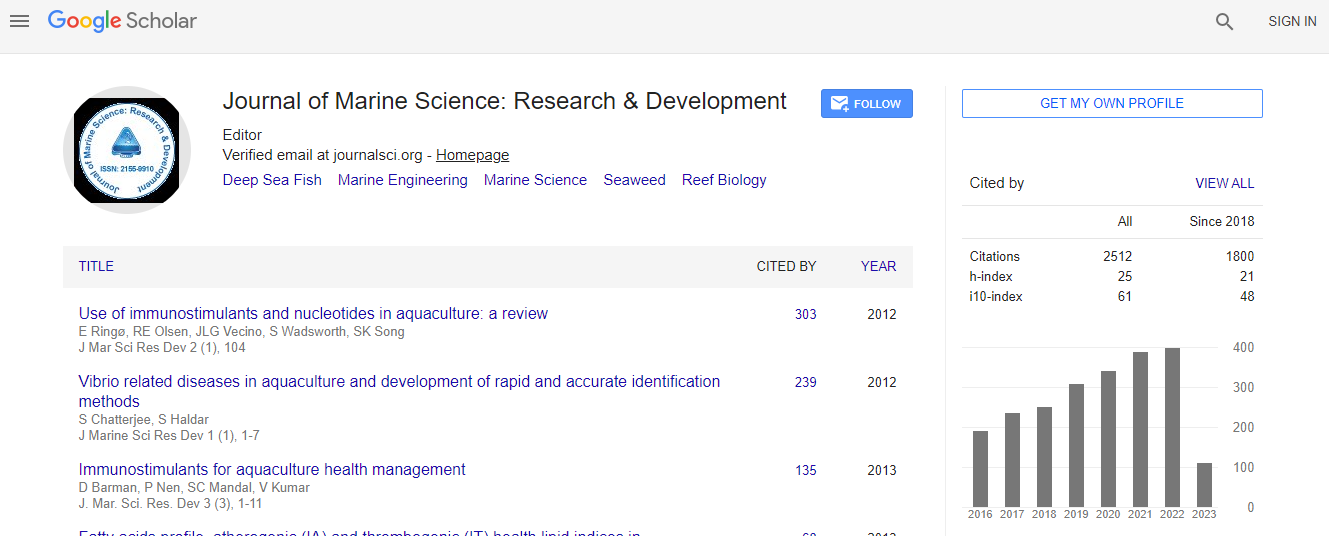Our Group organises 3000+ Global Conferenceseries Events every year across USA, Europe & Asia with support from 1000 more scientific Societies and Publishes 700+ Open Access Journals which contains over 50000 eminent personalities, reputed scientists as editorial board members.
Open Access Journals gaining more Readers and Citations
700 Journals and 15,000,000 Readers Each Journal is getting 25,000+ Readers
Google Scholar citation report
Citations : 3189
Indexed In
- CAS Source Index (CASSI)
- Index Copernicus
- Google Scholar
- Sherpa Romeo
- Open J Gate
- Genamics JournalSeek
- Academic Keys
- ResearchBible
- Ulrich's Periodicals Directory
- Electronic Journals Library
- RefSeek
- Directory of Research Journal Indexing (DRJI)
- Hamdard University
- EBSCO A-Z
- OCLC- WorldCat
- Scholarsteer
- SWB online catalog
- Virtual Library of Biology (vifabio)
- Publons
Useful Links
Recommended Journals
Related Subjects
Share This Page
Another method of measuring SWH with radar altimeter
4th International Conference on Oceanography & Marine Biology
Mikhail Kanevsky
Institute of Applied Physics - Russian Academy of Sciences, Russia
Posters & Accepted Abstracts: J Marine Sci Res Dev
Abstract
It is known that existing altimeters measure significant wave height (SWH) on the ocean surface with accuracy about 0.5 m. This accuracy is practically the same whether SWH is found using the shape of the echo-pulse or through conventional for altimetry processing of chirp pulses. We are going to propose the way to improve the accuracy of measurements SWH. The idea is to apply to altimetry the technique of forming the range resolution used in imaging radars. The imaging radar operating with large ranges forms the range resolution by passing the chirp pulse through the matched filter. The range size of resolution cell and the distance between neighbouring cells are determined by the chirp pulse bandwidth and by the filter adjusting, respectively. We propose to use this scheme in altimetry. In this case, the range resolution becomes the vertical resolution, and having formed the √ʬ?¬?lattice√ʬ?¬? of cells placed along the vertical one can receive the echo from different levels. Evidently, the main contribution in the altimeter echo is introduced by the horizontally (or nearly horizontally) oriented elements of sea surface. Such elements are concentrated mainly in the areas of wave roughs and tops (the latter when without breaking). Therefore, the echo-signal amplitude from these levels will significantly exceed ones from another levels, and wave height can be found rather exactly. The chirp pulse bandwidth, which is needed to provide the vertical resolution 20 cm, is found as 450 MHz. This value about in half exceeds the chirp pulse bandwidth of Envisat RA-2 and CryoSat (320 MHz) and practically coincides with that of SARAL/AltiKa (500 MHz). Thus, the essential increase in resolution can be reached through maintaining the same bandwidth or its relatively small increase. In order to avoid losing vertical resolution because of sphericity of the wave front of radiation as well of sphericity of the Earth, it is needed to have sufficiently narrow antenna pattern or to use only the part of the pattern, restricted by the cone close to nadir. As shown by numerical estimates, the vertical resolution 20 cm will not be lost if the angle width of mentioned cone does not exceed about (space altimeter) and (airborne altimeter).Biography
Mikhail Kanevsky has completed his PhD and Doctor of Sciences degrees from Gorky State University and the Institute of General Physics (Russia), respectively. His last position is Head Scientist at the Institute of Applied Physics, Russian Academy of Sciences. He is the author of more than 100 works (articles, reports, two books). Now, he is retired and lives in Canada.
Email: mbkanevskiy@gmail.com

 Spanish
Spanish  Chinese
Chinese  Russian
Russian  German
German  French
French  Japanese
Japanese  Portuguese
Portuguese  Hindi
Hindi 